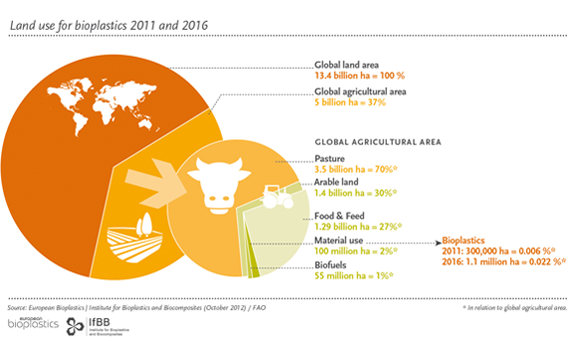The nova-Institute has recently published a paper on agricultural feedstock use in industrial applications shedding light on the controversial public debate surrounding the industrial use of food crops or so-called first generation feedstock. The core finding asserts that efficiency and sustainability assessed on a case-by-case basis should be the sole criteria in judging the choice of feedstock used. The institute further stresses that the real issue is land availability for growing biomass for different purposes.
The paper refers to studies asserting that, even after satisfying food demand of a rapidly growing world population, enough arable land would remain available for purposes other than food production. The best usage of these areas is achieved by considering the land-efficiency of different crops. Studies show that many food crops are more land-efficient than non-food crops. According to the paper, they require less land to produce the same amount of e.g. fermentable sugar (commonly used in biotechnology processes) than non-food crops or so- called second generation feedstock, e.g. lignocelluloses.
“Efficiency and sustainability should be the leading criteria when selecting renewable feed- stock for industrial purposes, such as the production of bioplastics”, said Hasso von Pogrell, Managing Director of European Bioplastics, embracing the paper as a welcome contribution to the discussion. “If the industry were to neglect the use of first generation feedstock at this point in time, it would do a disservice to society and the environment”, he added. “In addition to being currently more efficient, the use of food-crops for industrial purposes has the major advantage that, in times of food crisis, these crops could be reallocated to food use”.
European Bioplastics is in favour of promoting the use of second or even third generation feedstock for industrial purposes. However, as long as food crops continue in many cases to represent the most efficient feedstock by far, discrediting their use would be misguided and a step in the wrong direction in achieving the European Commission sustainability targets. “This often very emotional discussion needs to be steered into a more fact based direction”, continued Mr von Pogrell. “Only two percent of the global agricultural area is actually used to grow feedstock for material production and only 0.006 percent is used in the production of bioplastics, compared to 98 percent used for food, feed and as pastures”, he concluded.
These findings echo the conclusion of a study recently published by the World Bank, according to which an increase in food prices is largely influenced by the oil price. Biofuels and, by extension, bioplastics play a negligible factor here. The study looked at food commodities such as corn, wheat, rice, soybeans and palm oil and compared commodity prices to energy prices, exchange rates, interest rates, inflation, income and a stocks-to-use ratio to determine which of these drivers had the most impact on food prices.
- More Information
- refer to the European Bioplastics’ “facts & figures” brochure:
http://en.european-bioplastics.org/wp-content/uploads/2013/publications/EuBP_FactsFigures_bioplastics_2013.pdf - Information on land use is also presented as a graph in print quality:
– http://en.european-bioplastics.org/download/labelling/EuBP_Land_use_2013.jpg
- Download nova-Institute paper “Food or non-food: Which agricultural feedstock are best for industrial uses?”:
http://www.bio-based.eu/policy/index.php
Source
European Bioplastics, press release, 2013-08-12.
Supplier
European Bioplastics e.V.
nova-Institut GmbH
Share
Renewable Carbon News – Daily Newsletter
Subscribe to our daily email newsletter – the world's leading newsletter on renewable materials and chemicals












